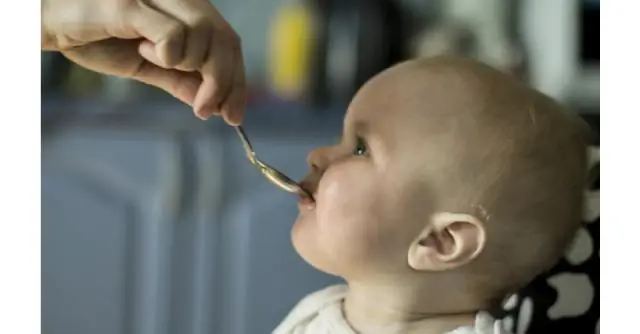- Author Rachel Wainwright [email protected].
- Public 2024-01-15 19:51.
- Last modified 2025-11-02 20:14.
Acyclovir for chickenpox in children: dosage, contraindications, side effects
The content of the article:
-
Characteristics of the disease
Rashes
- Chickenpox treatment
-
Instructions for use of Acyclovir
- Pharmacological characteristics of the drug
- Contraindications and features of use
- Overdose and side effects of Acyclovir
-
Cream and ointment with Acyclovir for chickenpox
Mode of application
- Video
Acyclovir for chickenpox in children can be used to relieve symptoms, reduce the likelihood of complications and unwanted effects of the virus on the child's body.

Acyclovir is an antiviral drug used for chickenpox
Chickenpox is a highly contagious childhood infection that occurs with fever, symptoms of intoxication, a characteristic rash on the skin and mucous membranes.
Chickenpox is one of the most common infections in the world. The disease is caused by the herpes group virus - Varicella Zoster. It has a tropism (the ability to penetrate and multiply) to the epithelial cells of the skin, mucous membranes and the nervous system.
The peak incidence of chickenpox falls at the age of 2-10 years. Almost all adults have antibodies to Varicellavirus.
Characteristics of the disease
It is possible to become infected with chickenpox only from a sick person by drip or contact. The virus enters the cells of the mucous membrane of the respiratory tract, multiplies and accumulates there. Then, breaking cells, it enters the bloodstream and is carried throughout the body, reaching the skin and neurocytes.
The incubation period lasts about 2 weeks (5-21 days). The disease begins suddenly with a rise in body temperature, weakness, loss of appetite.
Rashes
Rashes with chickenpox go through several stages. First, there is a spot caused by local expansion of the capillaries. Then a papule is formed, which is a tubercle that rises above the surface of the skin.

The disease is manifested by a characteristic itchy rash
The papule is transformed into a vesicle - a superficial cavity element that rises above the surface of the skin and contains serous fluid inside. In normal cases, the vesicle looks like a dewdrop on the skin, surrounded by a rim of redness.
In the future, the liquid becomes cloudy inward, and the tire becomes more compacted and covered with a crust.
For 4-6 days, new elements of the rash appear in waves. The same changes can occur on the mucous membranes of the oropharynx, conjunctiva, external genitalia.
Chickenpox treatment
Chickenpox belongs to the group of diseases that, with a mild course, require only symptomatic therapy aimed at combating fever, itching, and prevention of secondary bacterial infections.
For etiotropic treatment (drugs that can kill the chickenpox virus), the following can be prescribed:
- Acyclovir;
- Vidarabine;
- Virazole;
- Alpizarin;
- Famciclovir;
- Ganciclovir.
Instructions for use of Acyclovir
Acyclovir is a direct-acting antiviral drug that is active against the human herpes virus. Available in the form of tablets, solution for injection, cream or ointment for application to the skin.
Indications for treatment with Acyclovir:
- severe course of chickenpox (hemorrhagic, bullous, septic forms);
- oncological diseases;
- a history of organ or bone marrow transplantation;
- long-term treatment with glucocorticosteroids;
- congenital immunodeficiency;
- HIV;
- congenital chickenpox;
- complications of chickenpox (pneumonia, encephalitis, hepatitis, thrombocytopenia).
Pharmacological characteristics of the drug
The active ingredient of Acyclovir enters a cell infected with a virus and replaces a portion of the viral DNA. As a result, the synthesis of viral DNA chains stops, the pathogen can no longer multiply. The drug has no effect on cells not affected by Varicellavirus.
In the human body, Acyclovir does not bind to plasma proteins, and is excreted unchanged by the kidneys after 3-5 hours.
Contraindications and features of use
The only contraindication is hypersensitivity to drug components. No clinically significant interaction with other medicinal substances has been observed.

During the period of taking the drug, it is important to observe the drinking regime.
The drug can only be taken as directed by a doctor, strictly observing the dose, intervals of administration and duration of therapy. During treatment with Acyclovir, you should maintain a drinking regimen, avoid dehydration (you can often drink a small amount of water).
The maximum effect from the use of Acyclovir will be if it is prescribed in the first 48 hours from the onset of the disease (up to 24 hours from the onset of the rash).
Method of administration and dosage of the drug in children:
| Child's age | Dose | Multiplicity of reception | Duration of treatment |
| 2-6 years old | 400 mg | 4 times a day | 5 days |
| Over 6 years old | 800 mg | 4 times a day | 5-10 days |
For babies under 2 years of age, Acyclovir can be prescribed only in a hospital setting, since the dose must be calculated per kg of body weight and administered intravenously. Depending on the severity of the course of chickenpox, 10-20 mg / kg per day is administered, divided into equal parts 4 times a day at regular intervals.
The drug should be taken at a minimum interval of 4 hours with an eight hour break at night. In order not to miss the time when the child needs to take the medicine, parents can set reminders (for example, at 7:00, 12:00, 17:00 and 23:00).
Overdose and side effects of Acyclovir
Since only a small part of the drug is absorbed in the digestive tract, overdose is extremely rare. If you accidentally take a double daily dose for several days, you may experience:
- nausea;
- vomiting;
- headache;
- confusion of consciousness.
Side effects of Acyclovir:
| Affected organ | Symptoms |
| Blood and lymph | Anemia, thrombocytopenia |
| The immune system | Anaphylactic reaction |
| Nervous system | Headaches, tremors, convulsions, impaired consciousness, hallucinations |
| Respiratory system | Dyspnea |
| Digestive system | Nausea, vomiting, abdominal pain |
| Leather | Itching, urticaria, angioedema |
| Kidney | Increased concentration of creatinine, urea |
Cream and ointment with Acyclovir for chickenpox
This form of antiviral treatment is usually prescribed for children with severe chickenpox, massive rashes and severe itching.

With massive rash and severe itching, external agents with acyclovir are used
5% Acyclovir cream can be used in children from three months of age.
Mode of application
The product is applied in a thin layer using a cotton pad or stick to the affected and adjacent skin areas 5 times a day (every 4 hours with a night break of 8 hours). The course of treatment lasts from 5 to 10 days.
The program "School of Doctor Komarovsky" has an issue dedicated to the rules of treatment and skin care for chickenpox. In most cases, proper care avoids secondary infection and complications.
Video
We offer for viewing a video on the topic of the article.

Anna Kozlova Medical journalist About the author
Education: Rostov State Medical University, specialty "General Medicine".
Found a mistake in the text? Select it and press Ctrl + Enter.






